Glimpses of Theravada Buddhism; interview with Louis Gabaude
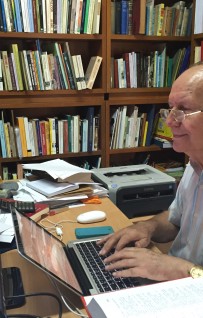
Louis Gabaude is one of the most knowledgeable scholars of Theravada Buddhism. He taught in Chiang Mai University and has been deeply involved in research on the field working for École Française d’Extrême-Orient or EFEO, in Thailand.
He’s now retired since 2007 and he still lives in Chiang Mai (Northern Thailand).
You can read the French version of this interview clicking here and the Italian one clicking here.
Could you please start by introducing yourself?
I was born in south central France. My grandparents had a small farm in the hills. My father, born in 1900, trained as a stonecutter at the age of 14. At 20, he was conscripted into the army and sent to Germany as a member of the “occupying forces” after WW I. Upon his return, he started his own enterprise and created his own factory, which would, after WWII, employ about 20 workers. Despite having only a primary education he became the mayor of our commune, created an association for the protection of the region, and received an academic distinction. My parents had five children.
Born in 1942, I was the youngest, cherished by all, and had a happy childhood in a forested environment. I grew up after the war and could pursue my studies rather easily, assuming the responsibility of achieving a higher education that had been refused to my father for socio-economic reasons.
In a way, however, I was not prepared for adulthood because my life as a child was too easy, too cozy, while adult life can be tough either because of external conditions or from our own stupidity.
Life is not for blissful kids. From the perspective I have now, my life may have been determined by a sentence my father loved to say: “At the age of twenty, one should leave France”. All my three elder brothers went abroad at 20… for their military service, like my father. My turn to be 20 came in 1962 at the end of the Algeria War. I volunteered for the French version of the Peace Corps, just created by General de Gaulle, himself inspired by Kennedy. I was sent to Laos at 22, in 1964. By that time I had studied philosophy and religion. I stayed in Laos till ‘66. I was posted to Pakxan, a small town on the Mekong, one hundred and fifty kilometers east of Vientiane where I taught French in a secondary school. It seems I am better remembered by my former students as a guitar teacher! When I served in Laos, the US started bombing Laos and North Vietnam with the results we know. We could hear their jets roaring to the North, we could smell the war; it was very near. The fighting did not affect me physically but, one time, a battle took place just 25 kilometers away. There were some casualties, from government forces and from the Lao communist guerillas. Two French journalists, from Le Figaro, a centre-right newspaper, wrote an article on the battle. They reported, say, ten dead government soldiers, ten Lao communist guerillas and five Vietnamese soldiers. But in Paris they just wrote about government and Lao soldiers only. Vietnamese soldiers fighting alongside Lao communists were not politically correct and could not be mentioned even in a rather rightist newspaper. This taught me about the relativity of public “truth”.
In another episode, we trekked to a Hmong village in the mountains. The village had been bombed by government forces a few weeks before. There was a small group of communist guerillas posted at a pass nearby and the military concluded that the villagers were also communists, so they bombed them. When the Government realized they had committed a counterproductive mistake, they—or the US behind them—paid for material to rebuild their houses. I could see how cruel war can be for innocent people, routinely victims of something that is totally beyond their grasp.
How did you develop interest for Theravada Buddhism?
In Pakxan I started to be curious about Buddhism. The reason was very simple. At that time I was learning the Lao language. During weekends I took my camera, walked around the town, and I noticed that the people easily available to talk with me in Lao were Buddhist monks because they were free and at ease with foreigners. In fact, even now, if you go in non-touristic areas trying to talk with people, ordinary folks don’t try to make any effort to talk with strangers, being afraid not to be able to have a conversation. The monks were not so shy and, on the contrary, wanted to improve their skills and show their knowledge. Talking with them I started to be interested in Buddhism. I read about it and when I returned to France, I took courses on Buddhism and on the history and civilization of South East Asia. I studied in Paris at the French School for Higher Studies (École Pratique des Hautes Études) which is a training school for research.
I came to Thailand in 1970, studied Thai, and then went back to Laos, teaching within the Catholic mission. I married in 1973 and settled in Bangkok. I started to teach at the Alliance Française and in 1974 moved to Chiang Mai University. In 1975, I got the diploma of the French School of Higher Studies with a study of the Buddhist ritual of building sand stupas. Maybe you know that, for the April New Year or other occasions, in Thailand, Laos, Cambodia and Yunnan, they build and offer sand stupas. I selected, translated and published texts written in Lao, Lan Na, Thai and Khmer scripts that explained the “material” and “spiritual” reasons why these sand stupas were built. In 1979 I completed my dissertation about Buddhadasa Bhikkhu (1906-1993) and in 1980 I got a research position in the French School of Asian Studies (École Française d’Extrême-Orient or EFEO). This institution had been created in 1900 to enable researchers to live in the very field of their studies. At that time most of the EFEO researchers were posted in Asia while now just half of them still work in Asia. As for me, I have stayed in Chiang Mai all along.
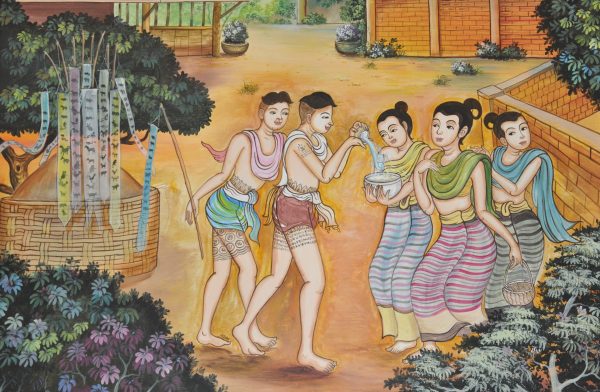 The sand stupas are reminiscent of sand mandala done in Tibet?
The sand stupas are reminiscent of sand mandala done in Tibet?
Not really. Near the border with Cambodia or in Cambodia, they build sand stupas reproducing Angkorian schemes. Angkor is sometimes interpreted as a kind of “mandala” but mandala has become a Western anthropological construction, a Tibetan scheme and cliché imposed upon Southeast Asia and often used without taking into account what people think or know.
Are they related to the concept of impermanence?
Yes. Sand flows between fingers like feelings between time. The texts I translated and wrote about are called anisong, from a Pāli/Sanskrit word meaning “advantage”. Most of these texts have two layers. The first one quotes ancient tellings borrowed from the so-called Buddhist “Canon” (the Tripitaka) or from ancient Commentaries, and the second layer gives spiritual and practical reasons for offering the stupas. The first part, the ancient layer, explains how in a former life the Buddha was a poor chap unable to offer a big solid stupa to the Buddha of his time and he could just build a sand stupa. He offered it to the Buddha and, for that reason, he was born, in his following life, in very prosperous or noble families and ended up as a Buddha. The purpose of the texts is to encourage people to offer this kind of stupa in order to get what, in Catholic Christianity, we call “indulgences”, and here “advantages”.
Did you do some research about pre-Buddhist cultures in South East Asia?
I cannot say I have any expertise on that but I have read a lot about it. You cannot study contemporary Buddhism if you ignore what was and is actually going on with spirits, Brahmanic or pre-Buddhistic reminiscences, whatever you call it. We, Westerners, have to be careful when we talk about that. Our brain remains Christian and we tend to think that religion is a set of clearly cut ideologies: if you’re a Christian you’re not Hindu or Muslim, if you are Catholic you’re not Protestant, etc., we rely on very schematic frozen categories.
The common question of westerners coming to Thailand and seeing Hindu gods in Buddhist temples is: are these people Buddhist or Hindu? But this is not a problem here. Buddha and the first Buddhists lived within an Indian worldview. They had a very “comprehensive” or “inclusive” view of life and the world. You’re born today as a man but tomorrow you’ll be reborn as a worm, a dog, or as a god. Cycles of lives and karmic retributions encompass all possible modes of being. Then even if there are “Hindu” gods in a “Buddhist” temple this does not mean that devotees of that temple see themselves as “Hindu”. It’s just that these “Hindu” gods are positions available for a while to anyone deserving this or that retribution.
How are these kinds of divinities considered? As particular developed spirits or what else?
Take the root of the Thai word “thewa” from Sanskrit “deva”. It comes from the Indo-European dev, related to “light”, which we find in Greek θεός, in Latin deus, and in all Latin languages under slightly various forms. But there is a great difference between the Buddhist “deva”, emerging out of the canopy of a teeming tropical jungle, and the Christian “Deus” created in an arid desert under a blue or starlit sky. In Buddhism, the deva are not “transcendent” to this world, they are a part of the conditioned circle of life, the samsara, and do not correspond to Deus/God (with a capital D) or to Allah. Here, in Buddhism, we are speaking of conditioned “deva”, with a small “d”. They are “contingent”, in Christian terms, submitted to the law of cause and effect, while God or Allah, by definition, are believed to exist “beyond”, elsewhere, in the indescribable.
Then, may they be ascribed a more metaphysical than theological dimension?
If you want to tell it in this way, yes, although a discussion about what you mean by “metaphysical” and “theological” would be useful. Again, it is important to underline we’re talking about deva with a small “d”. That’s why, for example, when the first missionaries came here, and talked about God and paradise, Buddhist monks didn’t understand these notions properly as “transcendent”. For Buddhist ears, the Christian discourse did not talk about anything transcendent, ultimate, or beyond conditions, but about a simple god and a heaven plainly submitted to the law of cause and effect.
Is your focus on Theravada Buddhism one of a scholar or do you also follow doctrines and practices?
I don’t want to say I’m Christian or Buddhist. Christian for what? Buddhist for what? Fundamentally I’m probably Christian and even Catholic if you do not ask me to sign every article of the Catholic Credo. I think that structurally, like all Europeans, I am a Christian and am fairly sure that what is best in me comes from Christianity. I do not speak of dogma or rites, but rather, of what, for me, is essential in Christianity: “he who does not love the brother he has seen, cannot love God whom he has not seen”. Therefore, I have not gone through the rejection of Christianity experienced by many in Europe, because they just ignore cultural history and whom they are, where they come from, and what they would be had Christianity not molded Europe. However, I’m certainly influenced by Buddhism and have become a kind of cultural blend, or a cultural monster perhaps! This may not be too much of a surprise in my case. My father was Catholic but he was also interested in “pagan” philosophy, specially the stoic side of it which, by the way, flourished from Benares to Rome. He had read Marcus Aurelius, Epictetus, and was familiar with the concept, or rather the observation, that there are two categories of things and events in this world: those you can change and those you cannot. Considering the second category of things, those you cannot change, it is vain to suffer for or from them. Everybody knows we will die, one day, then why to suffer in advance for that? Why add mental suffering to physical suffering? Isn’t that stupid? Is it not better just to accept it and enjoy the day? My father didn’t see contradictions between a “religious” Christian perspective and a “philosophical” pagan one. They just played on a different level. In the same way, Buddhism has taught me there are many things in life one must just accept and that we have to start thinking on the basis of life as it is. What monks teach to the folks is much more simple than what a parish priest teaches to children: you’re born, you become old, you suffer and, then, you die. Full stop. This is the first, and in a way the whole lesson of Buddhist “catechism”.
All other discourses flow from that mere consideration. By contrast, the first lesson I got from the Christian catechism was: “God is a pure spirit, who has created us in His image to serve and worship Him”. This is a dogmatic, imposed, artificial, metaphysical, disembodied “philosophy”, completely extraneous to a human daily life, to say nothing of a child life. So, in that way, it is true that I’ve been very much seduced by the practical basis of Buddhism which is essentially “existentialist”.
Of course I didn’t do or mimicked any social “conversion”. People call themselves “Buddhist”, “Christian” or “Muslim” because they need a “social” identity. In fact, they pretend to talk about their “spiritual” identity. This becomes odd and even funny. If you accept that these “religions” are ways of achieving “perfection”, and if you think perfection is something which cannot be completely achieved but only an objective to be pursued, then the fact that you call yourself “Buddhist”, or “Christian”, or “Muslim” implies that you feel satisfied and content with the fact that you’ve achieved the way to be “Christian”, or “Buddhist”, or “Muslim”, which is generally a total illusion. It works because it is an easy self-gratification born from the fact that you believe a few dogmas and observe a few rules. Look at what they did and are doing in the name of Buddha, God or Allah.
Look at how often you fail in your attempts to climb the path of your ideals. Thus, defining oneself as “Buddhist”, “Christian” or “Muslim” is a way to fall into the trap, the illusion, the aberration of an achieved “perfection”. Unless of course, like true Buddhist monks, you know that observing the rules is “training” [for something not yet achieved] or like Christian monks, you try to “convert” day after day [to a never completed perfection].
Here, we should also consider the case of institutions. It is in the nature of religious ideals to become institutionalized and, subsequently, fossilized because, sooner or later, people tend to work more for the sake of the institutions than for their ideals. This is a common fate of all human projects, however, and we cannot do anything about it: institutions are necessary for the ideal to survive and at the same time face sclerosis, erosion and crumbling.
Which kind of differences did you notice between Theravada Buddhism followed in Laos and the one followed in Thailand?
Religion in communist Laos is a complicated issue. Grossly speaking, at the beginning, when communists took power in 1975, the élite of the Party had naturally a strong faith in their Marxist/Leninist theory. For them religion was the opium of the people and, consequently, something to be suppressed. However, they were realists and clever enough to produce and promote thinkers who theorized that, up to now, “capitalists” had exploited Buddhism but that it could be interpreted in ways favorable to the exploited class. At the same time they were totally skeptical about the potential of Buddhism to heal social problems at the grassroots, unlike the communism of their dreams which naturally would solve everything. In the 10 years following their takeover, they proved and realized that their communist experiment was an economic failure and, as a result, they had to open their economy while skillfully keeping the system politically locked so that now Laos is a kind of state capitalist economy similar to those in China and Vietnam.
Another thing they discovered is that, after the end of the monarchy, there was nothing to unify the country because communism was too new and superficial a tool to restructure minds. Therefore, they realized, ironically, that Buddhism could be a tool to reunify and motivate minds. A kind of opium to cure another opium perhaps?
The identification of people with the monarchy in Laos was as strong as in Thailand?
No, in Thailand, until further notice, the monarchy is much stronger because the nationalistic unification of the country has been longer and rather efficient. One of the biggest differences between Laos and Thailand is that, since the 19th century, Laos, Cambodia, and Vietnam had been more or less administered by the French, who were not interested in Buddhist doctrine or discipline per se. The only thing they required was that monks should not be involved in any political irredentism. In Siam, by contrast, the kings have always been personally involved with Buddhism. The extreme case is King Rama IV or Mongkut who had been a monk—and a reformist one—for almost 30 years before he became king. He could not behave as a French distant ruler. In Thailand, the King and even the Government felt—and still feel—compelled to keep an eye on the way Buddhism is administered, studied and practiced. In Laos, before the communists and following the French line, the government didn’t intervene if Buddhist monks were not against them. But both Lao communists and Thai rulers have all (even if in different ways and with different purposes, of course) looked for more involvement with the sangha, or the monastic communities of their respective countries.
The rule to spend a period in monastery, in Thailand, is not compulsory for all the kings?
Yes it is the tradition for all males to become a monk for a short period of time and become “ripe”, as commoners, to “consummate” a wife, or for a royal prince to “consummate” a kingdom. Rama IV has been an exception with his long stay in the monkhood. Due to the fact that the King is Buddhist—according to modern Constitutions, the King must be a Buddhist—and because he is the protector of religion(s) (and first and foremost the protector of Buddhism), if he thinks the monks are not behaving properly, he is bound to intervene. As I already said, in Indochina, the French were not interested in the internal aspects of Buddhism, but in Theravada tellings and countries, kings have always checked monks’ behavior. Beginning with Ashoka in India, they have defrocked tens, hundreds of monks for the reason or the pretext that they were not faithful to the teachings or the rules of the Buddha. It seems that religion is too serious a thing to be left exclusively in the hands of monks!
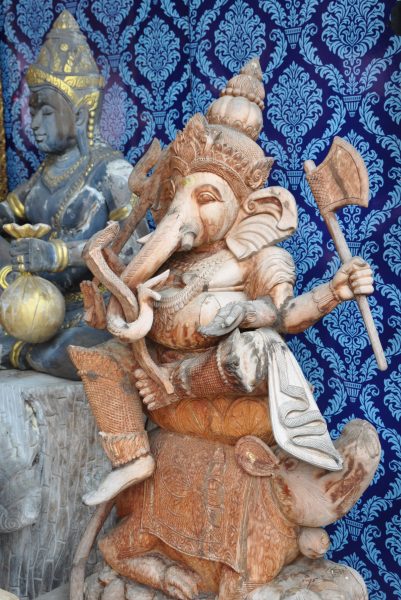 It is known Thailand, before being a Buddhist country, was very much influenced by Hinduism. Could you please tell us how Buddhism penetrated in the country?
It is known Thailand, before being a Buddhist country, was very much influenced by Hinduism. Could you please tell us how Buddhism penetrated in the country?
At the present time, I do not believe that one may date, with any certainty, the arrival of Buddhism in the area we call today Thailand. To begin, this depends upon what one reads, to whom one listens and, finally, to which Buddhism one is referring. If one listens to contemporary Thai Buddhists who quote their ancient chronicles, they are convinced that Buddhism arrived here during the reign of the Indian emperor Ashoka, who died 232 years before our common era. These envoys to our peninsular kingdom – Suvarṇabhūmi – should have introduced Buddhism at this site, notably, Nakhon Pathom, near Bangkok, where the great stupa stands as the as «monumental « proof » of this event. On the other hand, if we look for material evidence confirmed by archaeologists of the presence of Theravāda Buddhism in the basin of the Chao Phraya, we must wait until the period of the 6th to the 8th century to find inscriptions in the Pāli language that prove without reasonable doubt that the Theravāda tradition was active at the time. However, we can not know either a precise date of establishment or the place of origin – India or Sri Lanka – of this « initial » tradition. It is only for Theravāda Buddhism as we know it today here that its Singhalese origin may be confirmed back to the 13th century.
In pre-Buddhist times, rulers exercised power within a “Hindu” worldview, at least in their capitals and big cities. Even now, near the Buddhist King, you find Brahmins. Without them it is not possible to consecrate a Thai king in Bangkok. Brahmins have ritual duties and functions for the maintenance of monarchy. But if you ask me if a peasant in a remote village lives under the influence of Hinduism or Brahmanism, I would answer no. In the villages people believe in local spirits. When “religion” becomes sophisticated and develops an “intellectual” apparatus, some systematic hierarchy of powers has to be established. The spirits (phi) of villagers are upgraded into deva, yakkhas, etc., who share a place in the “Brahmanistic” and “Buddhist” imaginaire. But these are tricks or skillful means to help forest spirits and village people to set a position for themselves within the world and the scale of karma retribution. Their spirits, then, are not just primitive raw creatures but belong to the Hindu/Brahmanistic/Buddhist universe. Your question reveals something common in the West: we are used to applying a classificatory system of exclusion. Here, on the contrary, the cultural environment is more synthetic and Indian religious systems are inclusive.
Then, for what I’ve understood, the Brahmanic influences are more at an elitist level…
When they are systematized, yes. One must belong to the literate élite to know the texts, the rituals, the names and stories of “gods”, etc.; otherwise, people don’t mind and don’t care. If you bring a Thai man or woman into a cathedral in the West, he/she can light up a candle without any problem, because for them it is a way of expressing the same devotional attitude vis-à-vis something which is mysterious anyway and, therefore, can be perceived and named differently here and there. They do not see it as a “Catholic” thing alien to their “Buddhist” universe.
Talking about Thailand some people use the word “syncretism”, implying a mixture of Hindu gods, of spirit worship, and of Buddhist beliefs. If we intend to describe common practices, I don’t think it is correct to use “syncretism” because it supposes that there are closed systems contaminating each other. The play is not understood in that way here. Remember what we said about spirits and deva.
All living beings are all recycled into the same system, the same circle of life, within the contingency of a conditioned world, and this world of contingency is radically alien from the unconditioned Nirvana. Once again, I think the word “syncretism” is the result of a Christian perspective, the product of a Western mind conditioned by the Christian exclusive conception of “religion” or faith.
In its first centuries, Christianity built itself as a system of exclusive beliefs engineered through time into dogmas so that, in the end, if you don’t recognize them you’re not a “Christian”.
In the case of Asia, we can academically tolerate the word “syncretism” from the point of view of an observer who knows the different systems and looks at them as “systemically” different, but for the people believing and living in these systems, the word “syncretism” is, in my opinion, not correct.
Is it right, in your opinion, to involve in this kind of analysis even the psychological aspect? In other words, is it correct to think about people, in Asia, as having a different psychology in addition to a different culture?
Men have a natural tendency to identify and mistake reality with their own ideas about it. In Southeast Asia, most people do not conceptualize or theorize much beyond the theory of karma where nothing happens by chance but everything occurs through causes, and even quite “personal” causes, all marked, recorded and scattered along the thread encompassing their innumerable lives.
Folks usually leave sophisticated explanations to monks. They struggle to live doing their best to enjoy a decent life and to cope with basic “problems” of existence. They do not have an overt tendency to systematize and rationalize what they do beyond that karma theory; they react day by day to various circumstances and interpret events as fruits of their karma. This “totalizing” theory may be what differentiates “indianized” people from Westerners on the psychological level: we look for external causes to our problems while they know their own actions were and are the roots of whatever happens to them. The reason for their failures or achievements may be defined as “internal” because it belongs to their own personal past or recent actions. In the West, we tend to look always for “external” causes instead, as if we never were responsible for anything: yesterday, it was the Devil; recently, it has been capitalism or communism, or an ethnic group, or a nation; tomorrow some new devil, always out of us, or out of our social group, will pop up. For us, the karma theory is outdated and we long for other totalizing explanative theories. Even through our PhDs and academic works, we systematize everything and look for the same operative factor everywhere: “structure”, or “class-struggle”, or “power”, or “sex”, or “capital”, or any other intellectual rattle-of-the-day, so that, in the end, reality has to fit in the frame—the rattle—we have previously defined for it. The incidence of these totalizing explanations—be they “internal” or “external”—on the psychology of people opens the way to more discussion of course. To begin with, I do not think the discussion should talk about “Asia” as a unique or uniformed mold. India and China are very different, and Southeast Asia has borrowed from both, which leads of course to multiple psychologies in the same country.
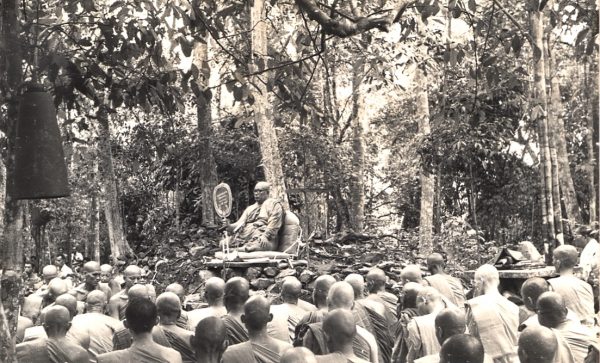 Could you please say some words about great Thai monks like Buddhadasa Bhikkhu and Achan Cha? They are the most known in the West. Are there some others less known in the West but deserving to be mentioned as well?
Could you please say some words about great Thai monks like Buddhadasa Bhikkhu and Achan Cha? They are the most known in the West. Are there some others less known in the West but deserving to be mentioned as well?
Let us begin by Buddhadasa Bhikkhu (in the photo). Many people have spoken of him, including myself. I became interested in his role because he challenged the image of a common Thai monk. He was a “creative monk” who tried to make Buddhism palatable for the educated middle class of his time, explaining Buddhism in such a way that educated people could “swallow” it. Rebirth, for example, could appear too childish or unbelievable, so he explained it as a psychological rebirth with a metaphorical meaning. He was then accused of negating the theory of “physical” rebirth and of karma through multiple lives but answered back that he did not refuse it but, rather, considered it non-productive, not useful for everyday life. People needed a Buddhism useful in the here and now. He was very interesting because he was a man of the modern world trying to reinterpret his tradition in a way that could be accepted by a man of the modern world. He tried to do that by going back to the origins of Buddhism, when it was not too much institutionalized, when the only institution was the newborn sangha.
 Achan Cha (1918-1992; in the photo),disciple of Achan Man (1870-1948), had a similar approach, a similar attention to the origin of Buddhism: Buddha left the royal palace, started to reflect on the human condition, and showed what can be done to be happy in the world as it is; he identified the solution in the taming and rejection of desires—because they lead to silly and unhappy results; the radical way to achieve that is to become a monk, to consecrate one’s time to reflect on what happens in the mind on every moment.
Achan Cha (1918-1992; in the photo),disciple of Achan Man (1870-1948), had a similar approach, a similar attention to the origin of Buddhism: Buddha left the royal palace, started to reflect on the human condition, and showed what can be done to be happy in the world as it is; he identified the solution in the taming and rejection of desires—because they lead to silly and unhappy results; the radical way to achieve that is to become a monk, to consecrate one’s time to reflect on what happens in the mind on every moment.
Both Buddhadasa and Cha stressed the need to return to origins. The difference is that Buddhadasa was asked to talk to an educated lay middle class while Cha was restricted to the creation of a monks’ community faithful to strict discipline and meditation.
He was using a more traditional language while Buddhadasa tried to communicate in a more modern way, often using English words.
What about the Dharmic Socialism of Buddhadasa?
Buddhadasa was accused of being communist, but his “communism” was a fiction. The accusation came mainly from the fact that he thought and said that the anticommunist governments were “immoral”. How can you bomb North Vietnam in the name of morality? He asked the US. A second and more subtle reason was that his apparent negation of physical rebirth was an implicit negation of the hierarchical and karmic model of a society where everyone gets a social position according to karma. But beyond these similarities, he did not have any faith in communism or communist regimes because they also were “immoral” or “non-dharmic”. Buddhadasa gave reasons why people turned to communism but he didn’t think communism could be the real answer. Finally, he said, communism would come out as a minor ripple on the sand which the waves of history will erase soon. History began actually to prove his prophecy right even before his demise.
In the Buddhist world and even sometimes in Buddhadasa’s words, there is a tendency to take Vinaya, the rules for Buddhist monks, as a model for a “socialist” society, which is, for me, totally anachronistic and structurally absurd. We’ve not to forget that the Buddha left the royal palace: that was the starting point, the primal act of the Prince Siddhartha before becoming a Buddha. He was, first and foremost, a renunciant, a sadhu, who came out of “politics” as a start. To consider the sangha as a model for lay society is totally incoherent. True, the sangha is not out of the world or physically separated from society, but it is actually by essence out of the normal and normative social rules of the world, i.e. work, social strata, and sexual reproduction. The only structural link between the sangha and the world is mendicity, this mandatory, daily contact between a layperson and the monk’s alms bowl. It is a link which, paradoxically, expresses the alien character of the mendicant monk free from any social obligation. All renunciants were living and still live now within a caste free company. But the Buddha did not pretend to abolish castes or classes in the society at large. That was not his business. A very interesting book to read is Sadhus, by the French author Patrick Levy who became a sadhu in India for one or two years. Reading that book, you will understand what Buddhism was at the origin because this is the life the Buddha and the first disciples led. The problem with monks and people who claim the sangha is the model for an egalitarian society is that they miss the original step of Buddhism: as a renunciant or a sadhu the Buddha rejected worldly responsibilities for the perpetuation of a lay society. Certainly, in the course of history, monastic communities—Buddhist or Christian—have influenced their respective surrounding societies but not as a model of internal organization. Certainly again, monastic communities—Buddhist or Christian—may be now the only places where communism is realized, but they can achieve that precisely because they do not play the rules of the lay world. So, taking them as a model for a lay society is a logically invalid proposal.
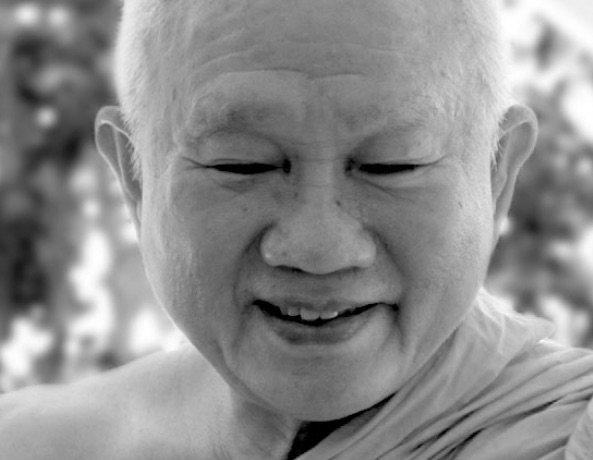 Now, besides Buddhadasa Bhikkhu and Achan Cha there are many other famous or influential monks, but there is one I’d like to talk about: Prayudh Payutto (b. 1938; in the photo). He is, for me, the model Theravada monk in Thailand. He’s the one who knows perfectly doctrine (Dharma) and discipline (Vinaya). He’s the voice of Dharma-Vinaya and, in a way, a voice of the Buddha, as Theravada Buddhism has understood him up to now.
Now, besides Buddhadasa Bhikkhu and Achan Cha there are many other famous or influential monks, but there is one I’d like to talk about: Prayudh Payutto (b. 1938; in the photo). He is, for me, the model Theravada monk in Thailand. He’s the one who knows perfectly doctrine (Dharma) and discipline (Vinaya). He’s the voice of Dharma-Vinaya and, in a way, a voice of the Buddha, as Theravada Buddhism has understood him up to now.
Prayudh Payutto can be considered as equivalent to Henri de Lubac (1896-1991) in Catholic theology or to Karl Barth (1896-1968) for Protestantism. Except for a fundamental difference: in Christianity, theologians periodically reformulate the Christian theological system because Christ never did it. They are free and even encouraged to do so. In Theravada Buddhism, by contrast, the Buddha has formulated everything perfectly and once for all. So, Theravada Buddhist masters can only go back, recall—and not even reformulate—the allegedly “original” teaching. Prayudh Payutto is accused of being too conservative but how can you really be a Theravada Buddhist monk if you’re not conservative? By essence, so called Theravada Buddhism is and has to be conservative. So accusing a Theravada Master of being conservative is totally absurd.
Besides these élite monks and meditation masters who have become very famous even in the West, most of the monks within the Thai sangha discreetly keep the system running, in all temples of all provinces. They run Buddhism as it is. And Buddhists, as they are, are often surprising: asking for material comfort while the Buddha renounced to it; asking for talismans while the Buddha repeated everyone is his/her own refuge; asking for life while the Buddha said death was unavoidable;
asking for paradise while the Buddha escaped from it; asking for erasing bad karma while karma law is immutable; and so on. So, talking about Buddhadasa, Cha, Prayut or meditation masters is not wrong but can make us forget the majority of monks who try to do their ordinary job by responding to ordinary needs of Buddhist folks. In spite of scandals regarding sex or money issues exposed by the media, they still give a moral structure to rural society. For how long? That is the question.
There are also many women leading groups of meditators as meditation masters. This is rather new, because fifty years ago there were not so many people spending two, three days, or one or two weeks in meditation sessions near a master. We are not talking enough about this phenomenon here, but it is very much alive.
Are you a meditator?
Practicing Buddhist meditation is like a musician practicing scales. But scales are not music.
Meditation sessions are trainings to rein the mind and prevent people to fall into various traps of desires. It is useful and probably necessary but personally I don’t feel the need to sit for this kind of sessions now. It is good of course that people do it but they often boast about it showing some sort of discreet vanity, which calls for a discreet smile. If they have understood what they are doing, why boast about it? For sure, meditation is or should be a therapeutic practice, first of all in the West where no one has a second to think about the way they think, about the reasons why they think what they think. Personally I’ve been trained as a Christian. I’ve practiced Christian meditation, which, although very different, is also in the end a means to train one’s mind and rein it into the expected ideal path. I’ve also reflected about many things, about silly things I did, about the roots of my sufferings. I try to observe my and others’ words and attitudes with a distant critical mind. I don’t see the necessity of sitting for one hour observing my breath “rising and falling”. I try to observe my mind in every moment, in every situation, when something usual or unusual is happening. In every moment of life you do have to be able to exercise the judgement Buddhists say you learn by or practice when meditating. Do you think the Buddha intended to train people only for the sake of training in artificial conditions? Just for the sake and the more or less masochist pleasure of repeated “scales” without end? Here, Buddhists often say that they “practice” (patibat) when they attend meditation sessions. I prefer to think that real life is the real practice. Meditation training can be justified if it aims to teach how to face daily events, daily emotions, daily people, so that, beyond scales, we know how to transform our life into real music.
(Thanks to Rebecca Weldon for polishing the text)
Manuel Olivares

 English
English Italian
Italian